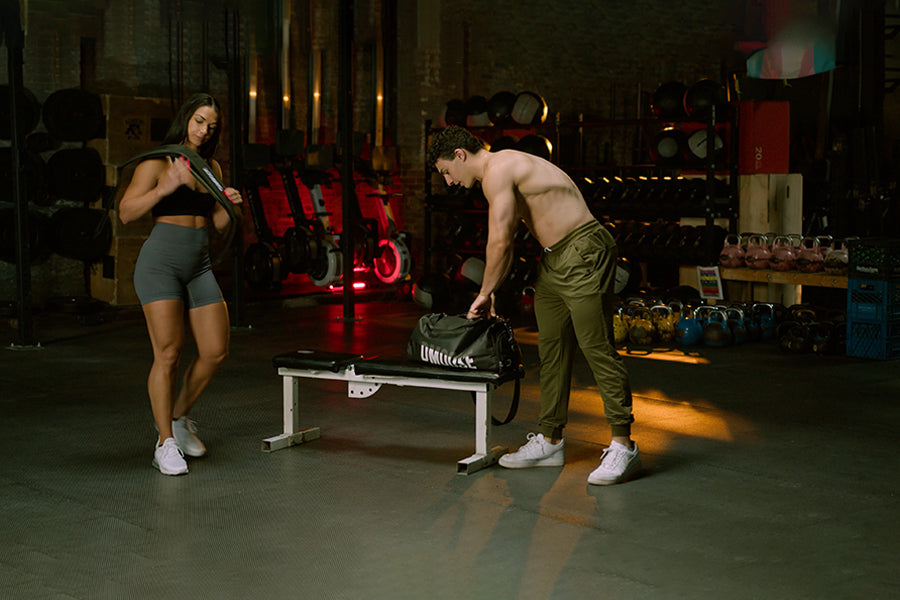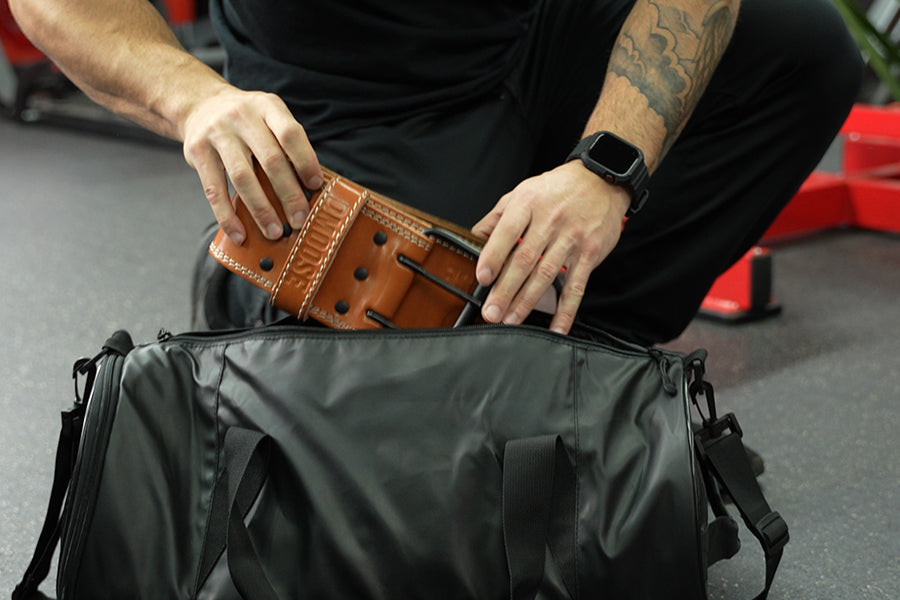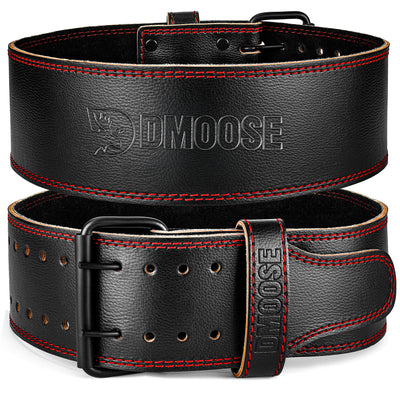Staying fit while traveling can be a challenge, especially for those dedicated to their lifting routines. Your lifting belt is an essential piece of gear, and knowing how to travel with it can make a significant difference in maintaining your fitness routine.
In this guide, we'll explore the best practices for packing and transporting your lifting belt, tips for navigating airport security with ease, and strategies to keep your gear in top condition.
5mm lifting belts are perfect for wearing, using, and obviously carrying along while you travel, as it's size won’t create a fuss during security checks.
However, if you have a different variant, passing security shouldn't be a problem either if you follow this guide. It will help you stay committed to your fitness goals, no matter where your journey takes you.
Packing Your Lifting Belt
Before we discuss airport security and regulations, let's look at the basics of packing your weightlifting belt for your journey. Properly preparing your belt for travel ensures it remains in excellent condition and is ready for use upon arrival.
Tips on Cleaning and Maintaining Your Belt Before Packing
The first step in ensuring your lifting belt is travel-ready is to clean and maintain it. Over time, sweat and grime can accumulate on your belt, and traveling with a dirty belt is less than ideal. Follow these steps to get your belt in top-notch condition:
- Wipe It Down: Use a damp cloth or mild cleaning solution to wipe the surface of your belt. This will remove any surface dirt or sweat residue.
- Air It Out: Allow your belt to air dry completely before packing it. Avoid packing a damp belt, as this can lead to unpleasant odors and potential mold growth.
- Check for Wear and Tear: Examine your belt for any signs of damage, such as frayed edges or loose stitching. If you spot any issues, consider addressing them before your trip.
Related Article: Weight Lifting Belt - the Absolute Protection You Need When Lifting Heavy Weights
Proper Folding and Storage Techniques to Avoid Damage

Now that your lifting belt is clean and in good condition, it's essential to fold and store it correctly to prevent damage during transit. Here are some tips:
- Fold it in Half: Gently fold your belt in half lengthwise, making sure not to crease or bend it too sharply. This will help it fit easily into your luggage without compromising its shape.
- Use a Soft Cloth: Consider placing a soft cloth or towel between the folded belt to provide additional protection and prevent friction-related wear and tear.
- Choose the Right Luggage: If you bring your belt in your carry-on bag, ensure you have a sturdy and well-padded compartment to keep it safe. For checked luggage, use a durable suitcase or bag to protect your belt from external pressure.
Using a Protective Bag or Case for Added Safety

For added peace of mind, consider investing in a protective bag or case specifically designed for lifting belts. Exercise accessories are available in various sizes and materials and offer extra protection during travel. Some benefits of using a protective bag or case include:
- Preventing Damage: These specialized cases are designed to shield your lifting belt from impacts, spills, and other potential hazards during your journey.
- Organized Storage: Many protective bags and cases come with compartments or pockets for storing other lifting accessories, such as wrist wraps or weightlifting gloves.
- Easy Identification: A distinctive case can help you quickly locate your lifting belt in your luggage or at the gym while on the road.
Now that your lifting belt is properly prepared for travel, let's discuss navigating airport security and complying with regulations.
Related Article: The Ultimate Weightlifting Belt Guide
Airport Security and Regulations
Traveling with a lifting belt means you'll need to pass through airport security checkpoints governed by various rules and regulations. Familiarizing yourself with these guidelines will help ensure a smooth journey with your precious lifting gear.
Guidance on Carrying Lifting Belts Through Airport Security
First and foremost, you can indeed bring a lifting belt through airport security. However, when going through the security screening, you'll be asked to remove certain items from your carry-on bag and place them in a bin.
Your lifting belt should be included in this category. Remove it from your bag and place it in a separate bin for X-ray screening.
Security personnel may ask about your lifting belt, as it may appear unusual on the X-ray screen. Simply explain that lifting belts is essential for training during travel as well. It's a fitness accessory for weightlifting, and you should have no issues.
Related Article: Why Weightlifting Belts Are Essential During Workouts?
Familiarize Travelers with TSA Rules and Regulations
The Transportation Security Administration (TSA) is responsible for setting the security regulations at airports in the United States. While these rules may vary slightly from country to country, understanding the TSA guidelines can serve as a useful reference point for travelers worldwide.
If your lifting belt has a metal buckle, it's a good idea to unbuckle it before placing it in the bin. This can help speed up the screening process and reduce the likelihood of additional checks.
Sometimes, TSA agents may need to perform additional screening on your lifting belt. This could involve a simple swab test to detect any traces of explosive materials. Cooperate with security personnel during this process.
Potential Issues and How to Address Them
While most travelers can breeze through airport security with their lifting belts without any problems, it's essential to be prepared for potential issues. Here are some common concerns and how to address them:
If you're traveling to a country where English is not widely spoken, it's a good idea to learn how to explain your lifting belt in the local language or have a written explanation ready.
If security personnel have questions or concerns about your lifting belt, remain patient and cooperative. They are there to ensure everyone's safety, and a polite explanation should usually suffice.
Now that you know how to handle airport security, let's explore the best strategies for packing your lifting belt based on your type of luggage.
Traveling With a Lifting Belt by Air

Depending on your choice between carry-on and checked luggage, you must adopt different packing strategies for your lifting belt.
Packing Strategies for Carry-On Vs. Checked Luggage
When it comes to traveling with your lifting belt, the decision between placing it in your carry-on or checked luggage boils down to your preferences and travel plans. Each option has advantages, and your choice will depend on factors like the size of your belt, your luggage capacity, and your overall travel experience.
If you opt to pack your ideally tight lifting belt in your carry-on luggage, you're prioritizing quick and easy access during your journey. This strategy is particularly advantageous when you want to ensure that your lifting belt remains within reach and protected throughout your trip.
By having it in your carry-on, you can swiftly navigate airport security, address any potential inquiries from security personnel, and even use it during layovers or delays.
On the other hand, placing your lifting belt in your checked luggage provides a different set of advantages.
When packed in your checked bag, your lifting belt is shielded from potential damage that may occur during the hustle and bustle of airport handling and security checks. You have more flexibility in terms of storage within your suitcase, enabling you to secure it among your clothes and other items for added protection.
Tips for International Travel and Customs Regulations
If you're embarking on an international journey, it's crucial to be aware of customs regulations that might affect your lifting belt:
Different countries have varying regulations on importing sports equipment and accessories. Some may have restrictions or require you to declare such items. Check the customs guidelines for your destination in advance to avoid any surprises.
If your lifting belt is relatively new and you have the original receipt, it's a good idea to keep it handy. Customs officials may ask for proof of purchase, especially if the belt is expensive or appears brand new.
Handling Your Belt During In-Flight and Layovers
Once you've successfully navigated airport security and boarded your flight, you might wonder how to handle your lifting belt during the journey and layovers.
If you've brought your lifting belt in your carry-on bag, find a suitable place to store it on the plane. The overhead compartment or the seat pocket in front of you are typically good options. Make sure it's secure and won't inconvenience other passengers.
Watch your carry-on bag and its contents during layovers, including your lifting belt. It's easy to get distracted in a busy airport, but you must ensure your gear is still with you.
Traveling by Land or Sea
While air travel comes with its own considerations, traveling by land or sea with your lifting belt also requires some planning.
Recommendations for Road Trips and Train Journeys
If you're hitting the road or taking a train to your destination, you have more control over your luggage and can use these tips:
Keep your lifting belt in your car or train compartment in a secure and easily accessible location. Avoid cramming it into an overstuffed bag or placing heavy items on top of it.
During rest stops or layovers on train journeys, take a moment to ensure your lifting belt is still safely stored and hasn't shifted or been damaged.
Cruise Ship Considerations for Weightlifters
Cruises can be a unique way to travel, and they offer their own considerations for weightlifters
Many modern cruise ships have well-equipped gyms with weightlifting equipment, including belts. Check with your cruise line in advance to see if you can leave your belt at home and use the ship's facilities.
If you decide to bring your lifting belt on a cruise, consider the same packing guidelines as for air travel, as you'll likely encounter similar security measures when boarding the ship. Once on board, store your lifting belt in your cabin or designated gym area. Cruise cabins often have ample storage space to keep your gear safe.
Ensuring the Safety of Your Lifting Belt During Transit
Whether you're traveling by air, land, or sea, ensuring the safety of your lifting belt during transit is essential. Here are some additional precautions to take. If you're concerned about theft or want an extra layer of security, consider using a small lock to secure the compartment where your lifting belt is stored.
Stay vigilant about your luggage in crowded or unfamiliar environments, especially if you've stored your lifting belt in checked baggage. While rare, luggage theft can occur.
Alternative Workout Options in Case You Can't Bring Your Belt
While we've covered how to bring your lifting belt on your travels, it's essential to have a backup plan in case circumstances prevent you from bringing it along.
You can maintain strength and conditioning with various bodyweight exercises, such as push-ups, squats, lunges, and planks.
Moreover, portable and lightweight resistance bands can be a suitable substitute for weightlifting belts. You may also research gyms or fitness centers at your travel destination. Many offer day passes or short-term memberships, allowing you to access the equipment you need.
Maintaining Your Lifting Belt on the Go
Even with careful packing and adherence to security regulations, your lifting belt may still experience wear and tear during your travels. Here's how to maintain it while on the go:
Continue to wipe down and air out your lifting belt during your trip, especially if you use it frequently. This will help prevent odors and maintain hygiene.
If you notice any damage or wear on your lifting belt, consider making temporary repairs with duct tape or fabric glue to keep it functional until you can seek professional assistance.
However, if your lifting belt sustains significant damage during your travels, consult a professional leatherworker or tailor to assess and repair it. Quality lifting belts are an investment, and it's worth preserving their integrity.
Emergency Repairs and When to Seek Professional Help
Sometimes, your lifting belt might require immediate attention or a professional repair. For example, if the buckle on your lifting belt becomes damaged or malfunctions, it must be repaired promptly. A faulty buckle can compromise the belt's effectiveness and safety.
Moreover, loose or frayed stitching can weaken your lifting belt and make it less reliable. Approach a leatherworker or tailor to re-stitch any problem areas.
If your belt suffers structural damage, such as a tear in the leather or a broken support, it's best to consult a professional to assess whether it can be safely repaired or needs replacement.
DMoose Weightlifitng Belt

When traveling, it's essential to choose a strong, durable weightlifting belt to ensure your gear withstands the rigors of the journey. DMoose offers high-quality lifting belts that are perfect for maintaining your fitness routine on the go.
When it comes to optimizing your weightlifting routine, having the right equipment is crucial. The DMoose Weightlifting Belt is designed to provide exceptional support and durability, ensuring you can lift heavier and safer. Its thoughtful design also makes it convenient for travel, so you can maintain your fitness routine on the go. Below are the key features that make this belt an essential addition to your fitness gear.
5MM Thickness

The 5mm thickness of the DMoose weightlifting belt offers exceptional stability during heavy lifts. This thickness ensures the belt can provide the necessary support to your core and lower back, helping to maintain proper form and prevent injuries.
Whether you're performing squats, deadlifts, or bench presses, the robust thickness of this belt gives you the confidence to push your limits safely.
Powerlifting Speciality
Designed specifically for powerlifting routines, the DMoose belt caters to the unique needs of powerlifters. Its construction and design are tailored to support the intense and demanding nature of powerlifting exercises.
The belt's specialization in powerlifting makes it an essential tool for athletes aiming to enhance their performance and achieve new personal records.
Top Quality

Crafted from high-quality, authentic leather, the DMoose weightlifting belt guarantees lasting durability. The premium leather not only provides a sleek and professional look but also ensures the belt withstands the wear and tear of regular use.
This top-quality construction means the belt will remain a reliable part of your workout gear for years to come, delivering consistent support every time.
Lumbar Support
The DMoose belt offers excellent lumbar support, which is crucial for safer lifting. By providing firm support to your lower back, the belt helps to maintain proper posture and alignment during lifts, reducing the risk of injury.
This lumbar support is especially beneficial for heavy lifting sessions, ensuring you can train harder and more safely.
Conclusion
you can carry any type of weightlifting belt through airport security while traveling. However, it's essential to select belts that are lightweight, easy to transport, and conveniently portable, whether worn or packed in your luggage.
Looking for the best travel-friendly weightlifting belts? Check out DMoose.com for all gym essentials you need.
Reading List
Can Wearing a Belt for Overhead Press Increase Performance?
Leather Vs. Nylon Lifting Belt: Which One Should You Get?
Nylon Belt Vs. Lever Belt — Here's Your Ideal Pick for Strength Training
What is a 10MM Lever Belt & How to Choose the Best One for Your Workouts?
What Does a Weightlifting Belt Do? 5 Benefits You Should Know














